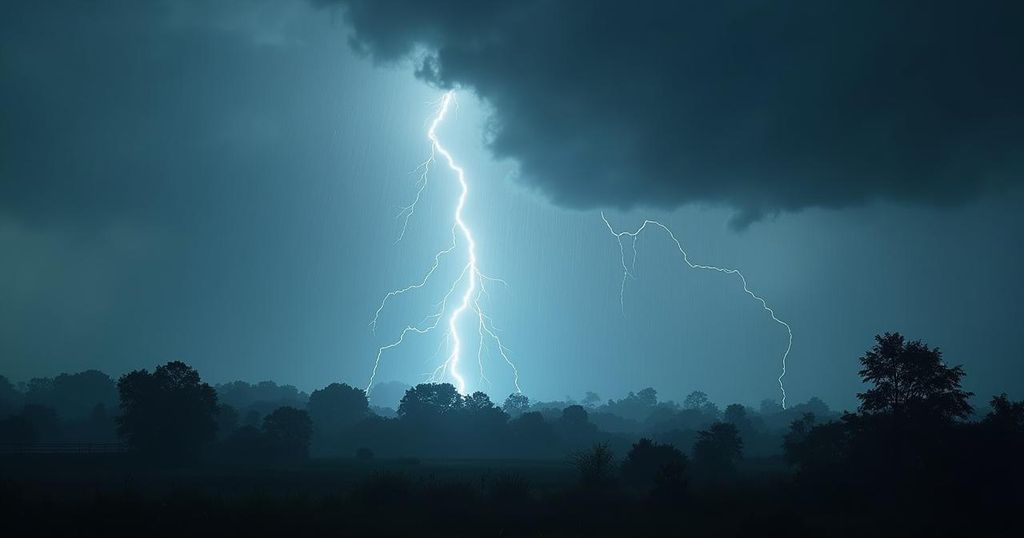Unprecedented Rainfall in Southeast U.S.: 40 Trillion Gallons from Hurricane Helene and Additional Storms
The Southeast United States recently experienced over 40 trillion gallons of rain from Hurricane Helene and a prior storm, leading to catastrophic flooding and significant loss of life. Meteorologists observe this as an alarmingly high volume of precipitation, with possible connections to climate change intensifying storm impacts.
In recent days, the Southeast United States has been inundated with an unprecedented volume of rainfall, totaling more than 40 trillion gallons, primarily due to the effects of Hurricane Helene and an additional rainstorm that preceded it. Meteorologists describe this phenomenon as a record-breaking occurrence, with the total amount of rain sufficient to fill the Dallas Cowboys’ stadium 51,000 times or cover the entirety of North Carolina with 3.5 feet of water. This staggering volume equates to over 60 million Olympic-size swimming pools. Ed Clark, who leads the National Oceanic and Atmospheric Administration’s National Water Center, remarked, “That is an astronomical amount of precipitation. I have not seen something in my 25 years of working at the weather service that is this geographically large of an extent and the sheer volume of water that fell from the sky.” The impact of these storms has resulted in catastrophic flooding, with reports estimating over 100 fatalities related to the deluge. Ryan Maue, a private meteorologist and former NOAA chief scientist, utilized both satellite data and ground observations to conduct his calculations, attributing 20 trillion gallons of rain directly to Hurricane Helene, while noting that preliminary assessments suggest an additional 1 to 2 trillion gallons may have fallen, particularly in Virginia. To provide context for the magnitude of this rainfall, Clark noted that it exceeds twice the combined capacity of Lake Powell and Lake Mead—two significant reservoirs in the Colorado River basin. Meteorological experts attribute this extensive rainfall to the convergence of multiple storm systems and persistent low-pressure systems that stalled over the region, allowing for the sustained accumulation of moisture from the Gulf of Mexico. Furthermore, the interaction of these storms with mountainous terrain significantly exacerbated the situation, drawing out additional moisture from the atmosphere. In North Carolina, weather officials reported their highest measurement of rainfall at 31.33 inches in Busick, with other areas experiencing similarly severe totals. Clark remarked on the increasing frequency of extreme rainfall events occurring in recent years, signaling a notable trend in climate-related changes. The conversation surrounding climate change has intensified, with experts, including Corbosiero and Dello, pointing to a direct correlation between rising global temperatures and heightened storm intensity and moisture capacity. Extensive analyses suggest that human-induced climate change may have increased rainfall by nearly 50% during Hurricane Helene in certain regions. In summation, this exceptional rainfall event serves as a poignant reminder of the profound impact that climate change has on weather patterns and the resulting potential for devastation. The combination of heightened moisture capacity and intensified storm systems poses significant challenges for preparedness and response strategies in affected regions.
The recent rainfall event in the Southeast United States, characterized by a total precipitation exceeding 40 trillion gallons, was primarily driven by Hurricane Helene and a preceding non-tropical storm system. Such a massive volume of rainfall has raised alarm among meteorologists and climate scientists, prompting rigorous analysis of precipitation data and resulting impacts. This scenario underscores the interplay of multiple storm systems exacerbated by geographical and climatic factors, notably the influence of climate change on storm behavior and precipitation patterns. The ensuing flooding has prompted discussions around the adequacy of current infrastructure and emergency response strategies in the face of increasingly extreme weather events.
The unprecedented rainfall in the Southeast, totaling over 40 trillion gallons, reflects a concerning trend toward more severe weather patterns exacerbated by climate change. The tragic loss of life and extensive flooding associated with this event highlight the urgent need to reassess how communities prepare for and respond to such meteorological challenges. Understanding the role of climate change in these intensified storms is critical as we move forward to develop more resilient systems and strategies.
Original Source: abcnews.go.com




Post Comment